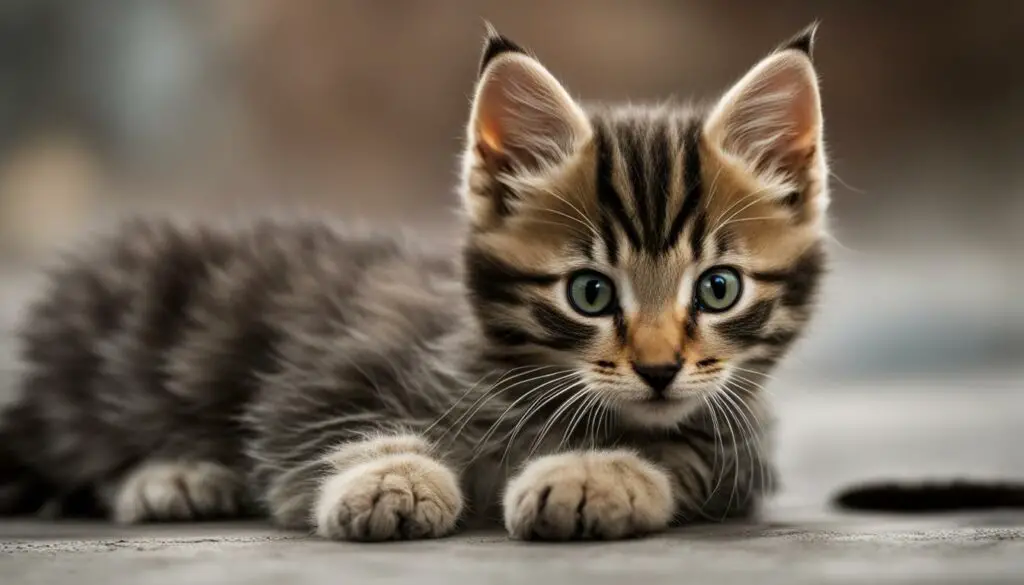Have you ever found yourself on the receiving end of your adorable kitten’s sharp claws and teeth? It can be confusing and even painful when your once cuddly companion suddenly becomes aggressive towards you. However, understanding the reasons behind your kitten’s attacking behavior is crucial for maintaining a harmonious and loving relationship.
In this article, I will explore the various factors that may contribute to your kitten’s aggression and provide insights on how to address this behavior. Whether it’s play aggression, petting-induced aggression, fear aggression, or any other form of aggression, we’ll delve into the underlying causes and offer practical solutions to help you and your furry friend navigate through this challenging phase.
Key Takeaways:
- Kittens may exhibit aggression due to playfulness, overstimulation, fear, territorial instincts, redirected aggression, pain, or maternal instincts.
- Recognizing and understanding your kitten’s body language is crucial for identifying signs of aggression.
- Redirecting your kitten’s energy towards appropriate toys and providing positive reinforcement for good behavior can help manage aggression.
- Creating a calm and secure environment, respecting boundaries, and seeking professional advice when needed are essential in addressing aggression issues.
- Patience, consistency, and a loving approach are key in building a harmonious bond with your kitten and preventing future aggression.
Play Aggression: Understanding Your Kitten’s Playful Nature
Kittens are known for their energetic and playful nature. Play aggression is a common behavior in kittens as they learn important hunting and social skills. However, it’s important to understand and manage this behavior to prevent it from turning into aggressive biting and scratching towards their owners or other household members. By redirecting their energy towards appropriate toys and providing positive reinforcement for good play behavior, you can help them develop appropriate play habits.
When engaging in playtime with your kitten, it’s crucial to keep your hands and arms at a safe distance. Avoid using your hands as toys or allowing rough play that can encourage them to bite or scratch. Instead, provide them with interactive toys, such as feather wands or small balls, that mimic prey and allow them to engage in natural hunting behaviors. Additionally, using puzzle toys or treat-dispensing toys can help satisfy their mental and physical stimulation needs.
Positive reinforcement is a valuable tool in managing play aggression. Whenever your kitten exhibits appropriate play behavior, such as chasing and pouncing on toys instead of attacking hands, offer praise and rewards. This will reinforce the desired behavior and help them understand what is acceptable during playtime. Consistency is key in training your kitten to redirect their play aggression towards appropriate toys and playmates.
| Signs of Play Aggression | How to Redirect Play Aggression |
|---|---|
| Scratching | Provide scratching posts and pads |
| Biting | Offer a variety of chew toys |
| Pouncing on feet | Redirect their attention to interactive toys |
| Chasing and attacking moving objects | Engage them in structured play sessions |
By understanding and addressing play aggression in kittens, you can ensure a safe and enjoyable play environment for both you and your furry friend. Remember to provide appropriate outlets for their natural behaviors, redirect their energy towards toys, and reinforce good play behavior. With patience and consistency, you can help your kitten develop into a well-behaved and happy companion.
Petting-Induced Aggression: Knowing Your Kitten’s Boundaries
When it comes to petting your kitten, it’s important to understand their boundaries and avoid overstimulation. Just like humans, kittens have different preferences when it comes to physical contact, and some may become aggressive if they are touched in ways they don’t enjoy. Recognizing the signs of petting-induced aggression is key to maintaining a positive relationship with your furry friend.
One of the most common signs of petting-induced aggression is a flicking tail, which indicates that your kitten is becoming irritated or overwhelmed. Other signs may include flattened ears, dilated pupils, or attempts to move away from you. If you notice any of these signs, it’s essential to respect your kitten’s boundaries and give them space. Avoid forcing physical contact and allow them to approach you on their own terms.
To prevent petting-induced aggression, it’s important to establish positive associations with touch from an early age. Start by gently petting your kitten in areas they enjoy, such as their chin or the base of their tail. Gradually introduce longer petting sessions and observe their reactions. If your kitten begins to show signs of discomfort, stop petting and give them a break. Remember, each kitten is unique, so be patient and adapt your approach to suit their individual preferences.
In summary, understanding petting-induced aggression is crucial for building a strong bond with your kitten. By recognizing their boundaries, respecting their preferences, and creating positive associations with touch, you can help prevent aggressive behavior and foster a loving and trusting relationship.
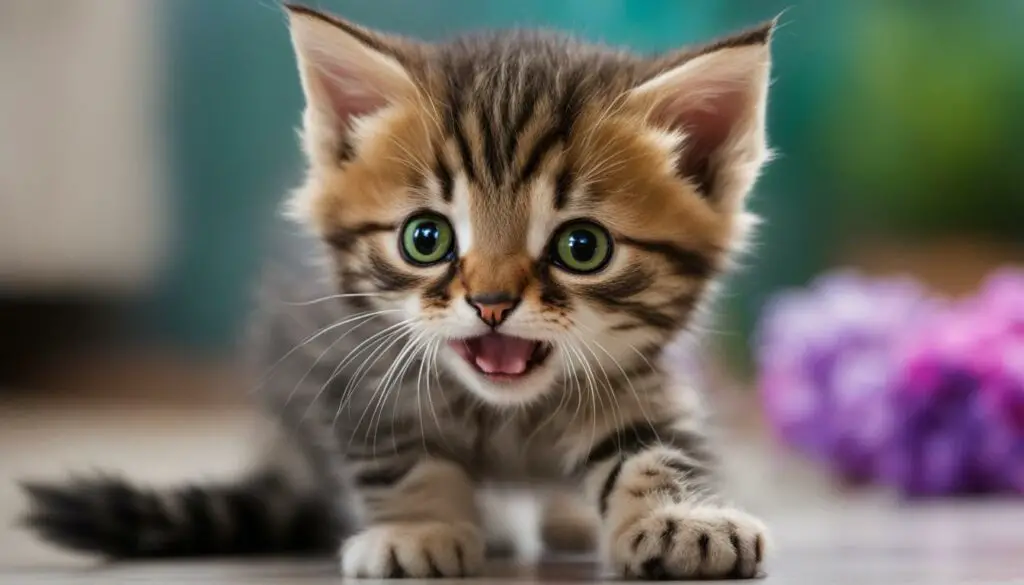
Table: Signs of Petting-Induced Aggression
| Signs | Meaning |
|---|---|
| Flicking tail | Sign of irritation or overstimulation |
| Flattened ears | Indicator of discomfort or fear |
| Dilated pupils | Sign of heightened arousal or stress |
| Attempts to move away | Desire for personal space |
Fear Aggression: Helping Your Kitten Feel Safe
Fear aggression is a common issue that many kitten owners may face. It occurs when kittens perceive a threat or feel unsafe in their environment, leading them to display aggressive behaviors such as hissing, growling, scratching, or biting. As a responsible pet owner, it is important to understand and address your kitten’s fear aggression to create a safe and harmonious environment for both of you.
Creating a calm and secure environment is crucial in helping your kitten feel safe and reducing fear aggression. Introduce new people and unfamiliar situations gradually, giving your kitten time to adjust and feel comfortable. Avoid forcing interactions and respect their boundaries. Use positive reinforcement techniques, such as treats and praise, to reward calm and non-aggressive behavior.
Additionally, gradual desensitization can help your kitten overcome their fears and reduce fear aggression. This involves exposing your kitten to the triggers of their aggression in a controlled and positive way, gradually increasing their tolerance over time. Seek guidance from a professional trainer or behaviorist who can provide expert advice and support in managing fear aggression.
Understanding Fear Aggression
Fear aggression in kittens is often triggered by specific situations or stimuli that they perceive as threatening. Common triggers include loud noises, sudden movements, unfamiliar people or animals, and stressful environments. By identifying and avoiding these triggers, you can help minimize your kitten’s fear and thus reduce their aggressive responses.
It is crucial to approach fear aggression with patience and empathy. Remember, your kitten is acting out of fear rather than malice. Punishment or harsh discipline will only escalate their anxiety and aggression. Instead, focus on positive reinforcement and creating a safe and secure environment for your kitten to thrive.
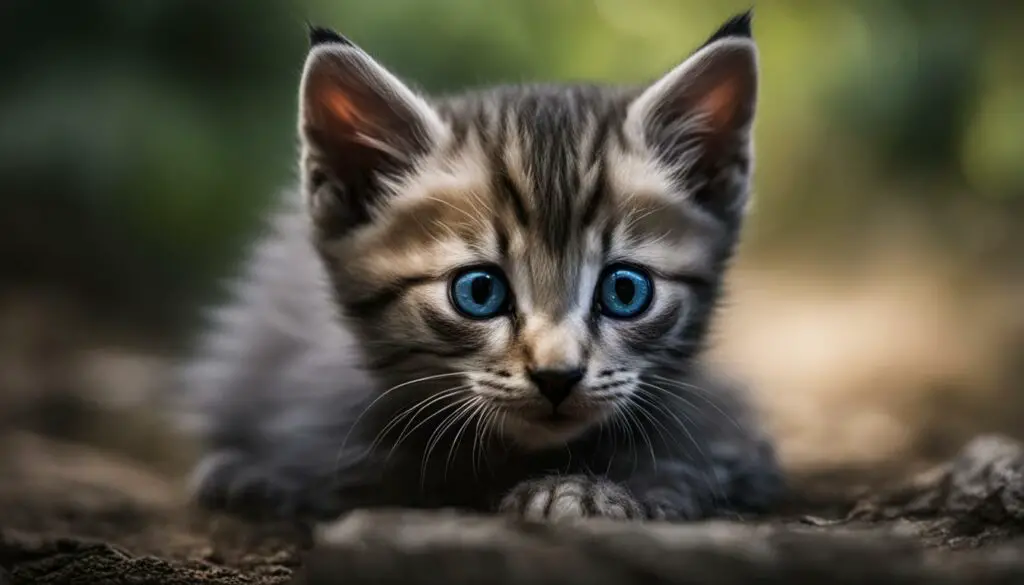
| Signs of Fear Aggression in Kittens | Ways to Help Your Kitten Feel Safe |
|---|---|
| – Hissing | – Create a calm and secure environment |
| – Growling | – Introduce new people and situations gradually |
| – Scratching | – Respect your kitten’s boundaries |
| – Biting | – Use positive reinforcement techniques |
| – Tail flicking | – Practice gradual desensitization |
Territorial Aggression: Understanding Your Kitten’s Need for Personal Space
One common reason behind kitten attacking behavior is territorial aggression. Kittens, like their wild ancestors, have an instinctual need for personal space and may become aggressive when they feel that space is being invaded. This aggression can manifest as blocking access to certain areas or displaying aggressive behavior towards people or other animals. It’s important to understand and address territorial aggression to maintain a harmonious relationship with your kitten.
Recognizing Signs of Territorial Aggression
Recognizing signs of territorial aggression can help you better understand your kitten’s behavior and implement appropriate measures. Some common signs include hissing, growling, scratching, or biting when others approach certain areas or objects. Additionally, your kitten may display defensive postures, such as crouching and flattened ears, to protect their territory. It’s essential to pay attention to these cues and respond accordingly to prevent potential conflict.
Managing Territorial Aggression
To manage territorial aggression in kittens, it’s important to provide a calm and peaceful environment where they feel secure. Avoid forcing your way into their designated spaces and instead, allow them to approach and interact with you on their terms. Reward calm and peaceful behavior towards others and redirect their attention to appropriate toys or activities when they display aggressive behavior. Consistency, patience, and positive reinforcement are key to addressing territorial aggression and creating a harmonious living environment for both you and your kitten.
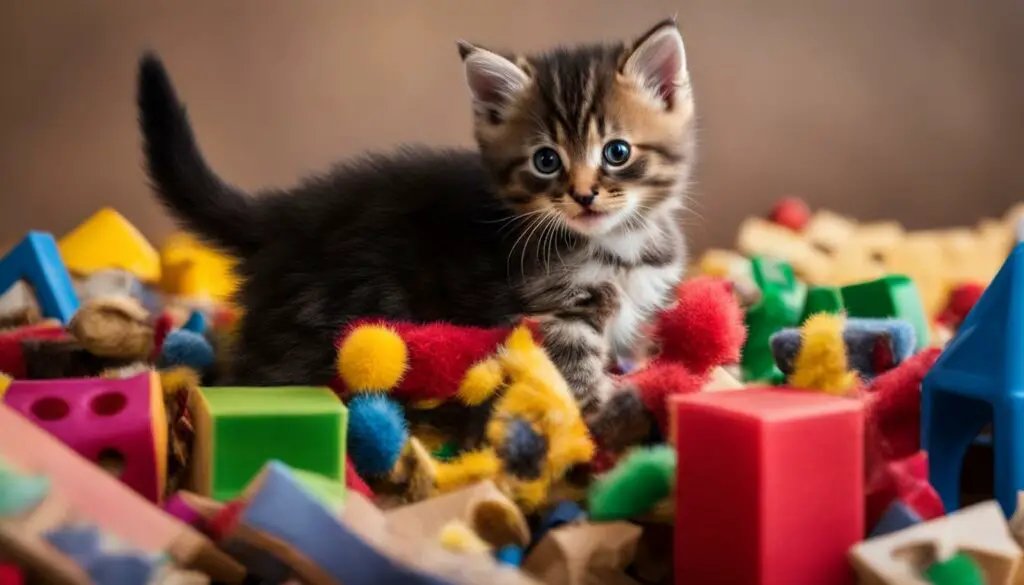
Maternal Aggression: A Protective Instinct in New Mother Cats
Maternal aggression is a natural behavior displayed by female cats who have recently given birth. As a protective instinct, mother cats may become aggressive towards familiar people or strangers who get too close to their kittens. This behavior is normal and should decrease as the kittens grow. To manage maternal aggression, it is important to provide a quiet and low-stress environment for the mother cat and limit contact with strangers. Respecting her need for space and avoiding any interactions that may trigger her aggression can help minimize conflicts.

It’s crucial to understand that mother cats are fiercely protective of their offspring, and their aggression stems from a desire to keep their kittens safe. By creating a secure environment and minimizing stressors, we can support the mother cat’s nurturing behavior and minimize the risk of aggressive incidents. Additionally, it’s important to remember that the mother cat’s aggression is not directed towards humans out of hostility, but rather out of a strong maternal instinct.
Maternal aggression is a natural behavior displayed by female cats who have recently given birth. This behavior is normal and should decrease as the kittens grow.
In situations where a mother cat displays aggression towards her owners, it is crucial to provide her with the space and calmness she needs. Avoid unnecessary handling or disruptions to her nesting area, and allow her to focus on caring for her kittens. By understanding and respecting the mother cat’s protective instincts, we can create a supportive environment that encourages bonding and reduces the risk of aggressive behavior towards owners.
Redirected Aggression: Dealing with Aggression Triggered by External Factors
Redirected aggression is a common behavior in kittens that can occur when they become agitated or overstimulated by an external stimulus. When faced with a threatening situation that they cannot directly respond to, kittens may redirect their aggression towards other cats in the household or even towards people. It’s important to understand and address this behavior to maintain a peaceful environment.
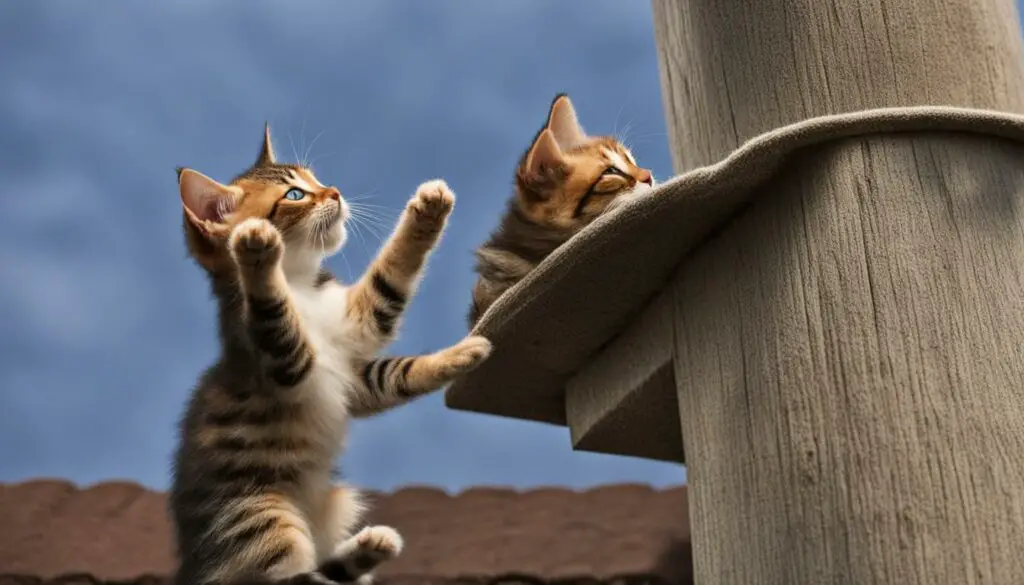
To effectively manage redirected aggression, it’s crucial to provide appropriate outlets for your kitten’s energy. Interactive toys, such as feather wands or puzzle feeders, can help redirect their focus away from the external stimulus and onto a more appropriate target. Engaging in playtime with your kitten using these toys can also strengthen the bond between you and provide a positive outlet for their natural hunting instincts.
Additionally, it’s essential to identify and remove the trigger that is causing the redirected aggression. If your kitten is becoming agitated by noises or sights from outside, consider closing curtains or playing soothing music to create a calmer environment. Providing a safe and secure space for your kitten, such as a separate room or a high perch, can also help reduce their exposure to potential triggers.
Remember, redirected aggression can be stressful for both your kitten and other household members. It’s important to remain patient and consistent in your approach. If you are struggling to manage redirected aggression or if the behavior becomes more severe, seeking guidance from a professional animal behaviorist or veterinarian is highly recommended.
Pain-Induced Aggression: Addressing Underlying Health Issues
Kittens may display aggression when they are in pain, such as from injuries or underlying health conditions like arthritis. It’s important to rule out any physical discomfort by consulting with a veterinarian. Treating the underlying cause of pain can often help resolve aggression associated with handling or petting.
When a kitten is in pain, their aggression may be a defensive reaction to protect themselves from further discomfort. To address pain-induced aggression, it is crucial to identify and treat the underlying health issues. A veterinarian can conduct a thorough examination and recommend appropriate treatment options.
“Pain-induced aggression in kittens can have serious implications for their well-being and the human-animal bond. Seeking veterinary help and addressing the underlying health issue is crucial for their overall quality of life.”
Table: Types of Pain-Induced Aggression
| Type | Underlying Cause | Treatment |
|---|---|---|
| Injury-related aggression | Physical trauma, such as a sprain or broken bone | Pain medication, rest, and possible surgery |
| Joint pain aggression | Arthritis or other joint conditions | Pain medication, weight management, physical therapy |
| Dental pain aggression | Dental issues, such as tooth decay or gum disease | Dental treatment, pain medication, proper oral hygiene |
Identifying and addressing pain-induced aggression is essential for ensuring the well-being of your kitten and fostering a positive relationship. By working closely with a veterinarian, you can develop a comprehensive treatment plan that reduces their pain and improves their behavior. Remember, a pain-free kitten is more likely to be a happy and non-aggressive companion.
Understanding Cat Body Language: A Key to Preventing Aggression
Understanding your kitten’s body language is crucial for recognizing signs of aggression and avoiding potential conflict. Cats communicate through a variety of subtle signals that can help us interpret their emotions and intentions. By paying attention to these cues, we can better anticipate and respond to their needs, ultimately preventing aggression.
Reading Your Kitten’s Body Language
Cats use their bodies, facial expressions, and vocalizations to convey their emotions. Here are some common signs of aggression to look out for:
- Upright stance, with fur standing on end
- Tail held straight up or thrashing back and forth
- Dilated pupils and intense stare
- Flattened ears against the head
- Hissing, growling, or yowling
These signals indicate that a cat may be feeling threatened or defensive. It’s important to respect their boundaries and give them space when they exhibit these behaviors.
Creating a Safe and Stress-Free Environment
To prevent aggression in your kitten, it’s crucial to create a safe and stress-free environment. Provide hiding spots, perches, and vertical spaces where your kitten can retreat to when they feel overwhelmed. Additionally, make sure to provide plenty of mental and physical stimulation through interactive toys, scratching posts, and play sessions. A well-enriched environment can help reduce stress and prevent behavioral problems.
Positive Reinforcement and Training
Positive reinforcement training can be a powerful tool in preventing aggression and promoting good behavior in kittens. Reward your kitten for desirable actions, such as using a scratching post instead of furniture or playing gently. Use treats, praise, and petting to reinforce positive behaviors. This will help your kitten associate good behavior with positive outcomes and strengthen your bond.
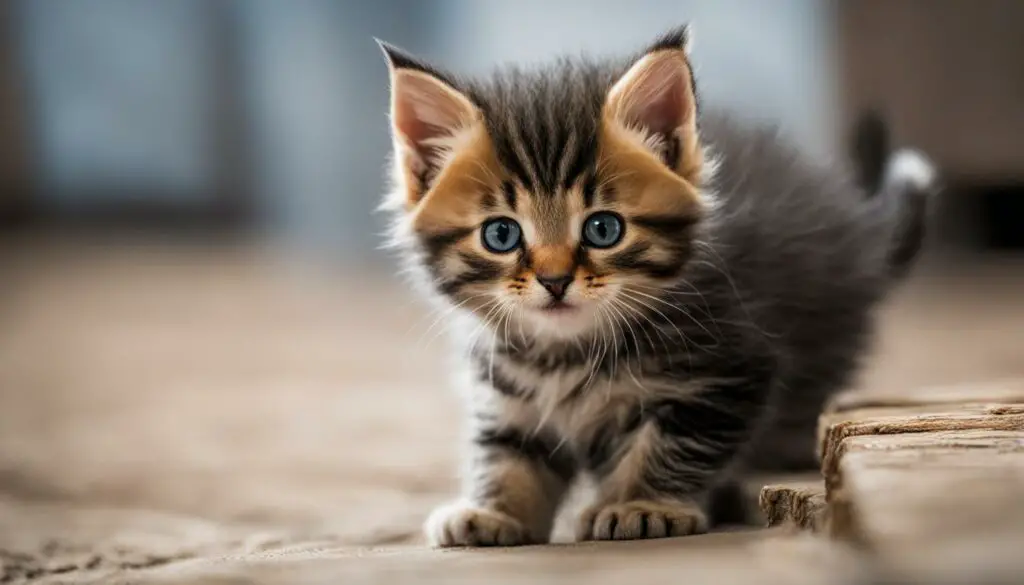
By understanding and interpreting your kitten’s body language, you can proactively address any potential aggression and create a peaceful and harmonious environment for both you and your feline companion.
Classification of Aggressive Behavior: Identifying the Motivation
Understanding the classification of aggressive behavior can provide valuable insights into why cats exhibit aggression and help guide appropriate interventions. Identifying the specific motivation behind your cat’s aggression is crucial for implementing targeted strategies to address the issue effectively.
Aggressive behavior in cats can be categorized into various types, including aggression between cats, fear or defensive aggression, territorial aggression, play aggression, redirected aggression, and pain-induced aggression. Each type has its own underlying causes and triggers, which require different approaches for management and resolution.
Table: Classification of Aggressive Behavior in Cats
| Aggression Type | Causes and Triggers | Management Strategies |
|---|---|---|
| Aggression between Cats | Competition for resources, dominance, territorial disputes | Separation, gradual introduction, environmental enrichment |
| Fear or Defensive Aggression | Perceived threat, feeling unsafe or cornered | Creating a safe environment, desensitization, positive reinforcement |
| Territorial Aggression | Protecting their space, perceived intrusion | Respecting boundaries, rewarding calm behavior, redirection |
| Play Aggression | Developing hunting skills, excess energy | Redirecting energy towards appropriate toys, positive reinforcement |
| Redirected Aggression | Agitation from an external stimulus | Removing stimulus, providing appropriate outlets for energy |
| Pain-Induced Aggression | Underlying health issues, injuries, discomfort | Consultation with a veterinarian, pain management |
Assessing the circumstances surrounding your cat’s aggression and observing their body language can help determine the appropriate classification. Seeking guidance from a veterinarian or animal behaviorist is advisable, as they can provide expert insights and personalized recommendations based on your cat’s unique situation.
Kitten Biting: Understanding Normal Kitten Behavior
When it comes to kittens, biting is a normal part of their development. As they explore their environment and learn to hunt, biting helps them sharpen their teeth and establish boundaries. It’s important to understand that biting in kittens is not always aggressive behavior but rather a natural instinct. By providing appropriate outlets for their biting behavior, you can help redirect their energy and prevent future aggression towards people.
Teething also plays a role in a kitten’s biting behavior. Just like human babies, kittens go through a teething phase where their baby teeth are replaced by adult teeth. This process can be uncomfortable, and chewing helps alleviate the discomfort. Providing chew toys specifically designed for teething kittens can be beneficial in redirecting their biting behavior away from your hands and furniture.
Remember, consistency is key when addressing biting behavior in kittens. Avoid using your hands or fingers as toys, as this can encourage them to view biting as an acceptable form of play. Instead, offer interactive toys that stimulate their instincts and provide a positive outlet for their energy. By understanding and responding appropriately to normal kitten biting, you can help them develop appropriate play behavior and foster a loving bond.
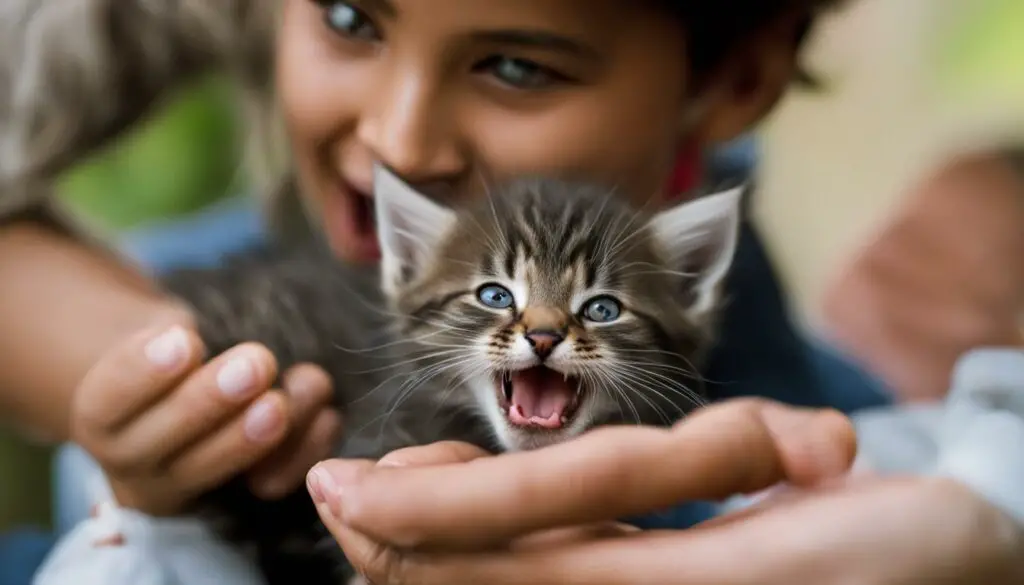
| Key Points: |
|---|
| Kitten biting is a natural behavior for exploration and hunting. |
| Teething can contribute to increased biting behavior. |
| Provide appropriate outlets for biting, such as chew toys. |
| Avoid using your hands as toys to discourage biting. |
Sudden Biting When Petting: Recognizing Overstimulation in Cats
Have you ever experienced a moment when you were petting your cat, and suddenly, out of nowhere, they bite or scratch you? This sudden biting behavior can be confusing and may leave you wondering what went wrong. However, it’s important to understand that this type of behavior is often a result of overstimulation in cats.
Overstimulation in cats occurs when they reach a threshold where they become overwhelmed by the physical interaction. Signs of overstimulation can include tail flicking, ears flattening, dilated pupils, or a change in body posture. When you notice these cues, it’s important to immediately stop petting your cat and give them some space to calm down. Continuing to pet an overstimulated cat can lead to aggression and potential injury.
To prevent overstimulation and sudden biting when petting, it’s crucial to learn and recognize your cat’s body language. Every cat is unique, and they may have different tolerance levels for physical contact. By closely observing your cat’s behavior during petting sessions, you can identify when they’ve had enough and adjust your interactions accordingly.
“Overstimulation in cats can be compared to the feeling of someone tickling you until it becomes too much. Your cat may love being petted, but there will always be a limit to how much physical contact they can handle.”
Remember, every cat has their own comfort zone, and it’s important to respect their boundaries. If your cat consistently displays overstimulation and sudden biting behavior, it may be helpful to consult with a veterinarian or a professional animal behaviorist who can provide guidance and help you develop strategies for managing this behavior.
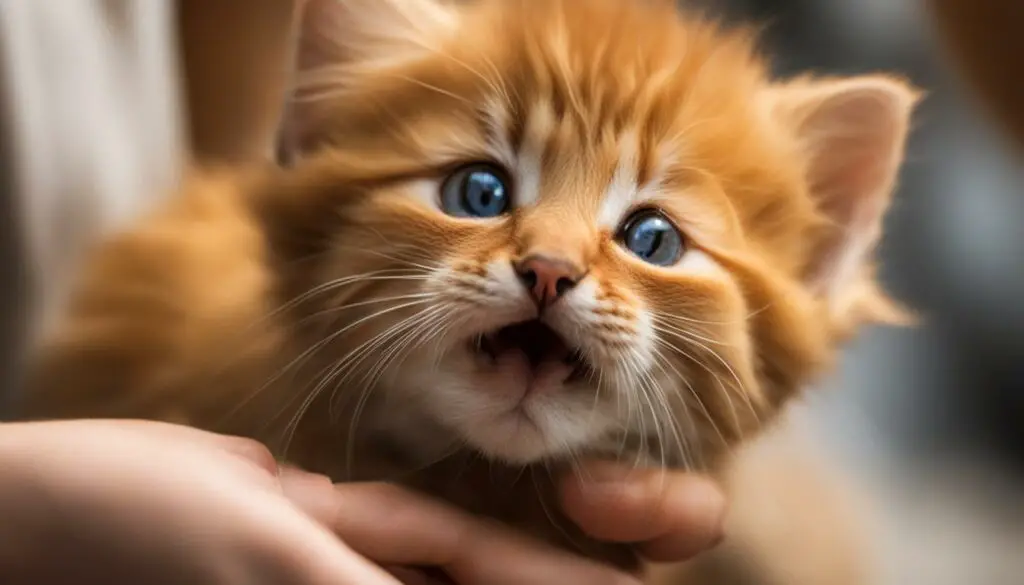
Love Bites: Affectionate Nibbles from Your Cat
If you’ve ever experienced your cat gently nibbling on you, you may be wondering what this behavior means. These “love bites” are often seen as a sign of affection from your feline friend. It’s a behavior that closely resembles the way a mother cat grooms her kittens, and it’s their way of showing their bond with you. While love bites are generally harmless, it’s important to set boundaries to ensure they don’t become too aggressive or painful.
When your cat gives you a love bite, it’s a form of communication. They may use this behavior to express their love and trust in you. It’s their way of saying, “I feel comfortable and safe with you.” However, it’s essential to redirect their behavior if it becomes too rough or hurts. You can gently withdraw your hand or provide an appropriate toy for them to nibble on instead.
“Love bites are a cat’s way of showing affection and trust. They’re a reminder of the special bond between you and your furry friend.”
It’s important to note that some cats may be more prone to love biting than others. Factors such as their upbringing, socialization, and individual personality can influence this behavior. If you find that your cat’s love bites are becoming too aggressive or frequent, it’s advisable to consult with a veterinarian or a professional animal behaviorist for guidance.
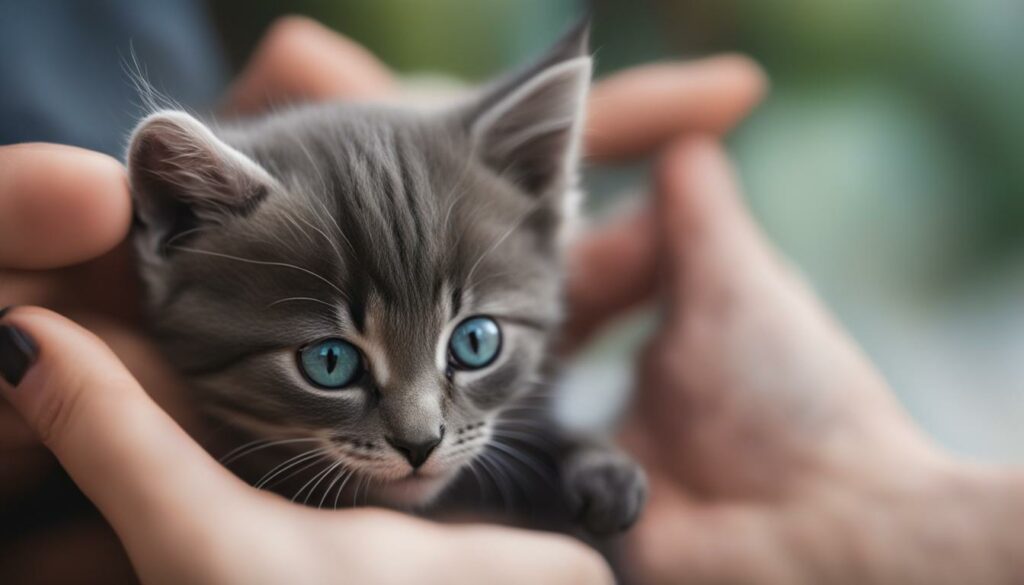
The Key to Understanding Cat Grooming Behavior
A related behavior to love biting is cat grooming behavior. Cats spend a significant amount of time grooming themselves and sometimes even groom their human companions. This grooming behavior is a sign of trust and affection. It’s their way of showing that they consider you part of their social group.
Grooming behavior is also essential for cats to maintain their cleanliness and health. It helps to remove dirt and debris from their fur, stimulates blood circulation, and spreads natural oils that keep their coat healthy and shiny. So, when your cat grooms you, it’s not only a sign of affection but also a way of including you in their grooming routine.
Conclusion
In conclusion, understanding the reasons behind your kitten’s aggression is key to preventing cat bites and fostering a positive bond with your furry friend. By recognizing the various factors that contribute to kitten aggression and taking appropriate measures, you can manage and redirect their behavior.
Creating an enriched environment with plenty of interactive toys and outlets for natural behaviors is essential in preventing destructive play aggression. Additionally, respecting your kitten’s boundaries and providing them with space when they show signs of overstimulation or petting-induced aggression can help maintain a harmonious relationship.
If your kitten exhibits fear, territorial, or pain-induced aggression, it’s crucial to address any underlying issues and seek professional advice from a veterinarian. By creating a calm and secure environment and gradually desensitizing them to triggers, you can help alleviate their aggression and promote a sense of safety and trust.
Remember, patience and consistency are key when dealing with kitten aggression. By employing positive reinforcement techniques and setting clear boundaries, you can guide your kitten towards appropriate behaviors and prevent future incidents of aggression. With time and understanding, you can develop a strong and loving bond with your kitten that lasts a lifetime.
FAQ
Why does my kitten attack me?
There can be several reasons behind your kitten’s aggression, including play aggression, fear aggression, territorial aggression, petting-induced aggression, redirected aggression, pain-induced aggression, or maternal aggression. Understanding the specific cause can help you address and manage the behavior effectively.
How can I deal with play aggression in my kitten?
Play aggression is a natural behavior in kittens as they learn hunting skills. To manage it, provide appropriate toys for them to play with and redirect their energy towards those toys. Avoid using your hands or arms as play objects to prevent them from turning their playfulness into aggressive biting and scratching. Rewarding good play behavior can also help reinforce appropriate play habits.
How can I recognize and avoid petting-induced aggression in my kitten?
Pay attention to your kitten’s body language, such as tail flicking or ear flattening, which may indicate that they are becoming overwhelmed by petting. If you notice these signs, respect their boundaries and give them space. Avoid petting them when they show signs of aggression and focus on positive reinforcement for calm behavior.
How can I help my kitten feel safe and reduce fear aggression?
Creating a calm and secure environment for your kitten is crucial. Gradual desensitization to new people or unfamiliar situations can help alleviate fear aggression. Offering positive reinforcement when they display calm behavior in those situations also helps build their confidence.
What can I do to manage territorial aggression in my kitten?
Ignoring the kitten and rewarding calm and peaceful behavior towards others can help manage territorial aggression. Setting clear boundaries and providing them with appropriate spaces that they can feel possessive over can also help reduce their aggression.
How can I minimize maternal aggression in my new mother cat?
Give the mother cat a quiet and low-stress environment while her kittens are young. Limit contact with strangers and ensure the mother feels secure and protected. As the kittens grow, the maternal aggression should decrease naturally.
How can I address redirected aggression in my kitten?
Providing appropriate outlets for your kitten’s energy, such as interactive toys, can help manage redirected aggression. Removing or avoiding the external stimulus that triggers their aggression is also important. Gradual reintroduction and positive reinforcement can help redirect their attention to more appropriate behaviors.
What should I do if my kitten displays pain-induced aggression?
If you suspect that your kitten’s aggression is due to pain, consult with a veterinarian to rule out any underlying health issues. Treating the underlying cause of pain can often help alleviate pain-induced aggression associated with handling or petting.
How can I understand my kitten’s body language to prevent aggression?
Understanding your kitten’s body language is crucial for recognizing signs of aggression and avoiding potential conflict. Offensive postures like an upright stance or direct staring indicate a potential attack, while defensive postures like crouching or flattened ears suggest fear or self-protection. By learning to interpret your kitten’s body language, you can better anticipate and respond to their needs.
What are the different classifications of aggressive behavior in cats?
Aggressive behavior in cats can be classified based on the motivation behind the aggression. These classifications include aggression between cats, fear or defensive aggression, territorial aggression, play aggression, redirected aggression, or pain-induced aggression. Identifying the specific classification can help develop a targeted approach to managing the aggression.
How can I address normal kitten biting behavior?
Kitten biting is a natural behavior as they explore their environment and develop their hunting skills. Providing appropriate outlets for their biting behavior, such as interactive toys and chew toys, can help redirect their focus. Understanding that teething can contribute to increased biting behavior can also help you respond appropriately.
What should I do if my cat suddenly bites or scratches when petted?
Sudden biting or scratching during petting may indicate overstimulation in cats. Pay attention to your cat’s body language and recognize signs of overstimulation, such as tail flicking or tense body posture. If you notice these signs, stop petting and give your cat space to calm down and regroup.
Is it normal for my cat to gently bite me as a sign of affection?
Some cats may exhibit gentle nibbling or biting as a sign of affection, reminiscent of how a mother cat grooms her kittens. This behavior is usually not a cause for concern and is a reflection of your cat’s bond with you. However, if the biting becomes too aggressive or painful, it’s important to set boundaries and redirect their behavior towards more appropriate forms of affection.
How can I prevent cat bites and foster a positive relationship with my kitten?
Understanding the reasons behind your kitten’s aggression and taking appropriate measures to manage and redirect their behavior is crucial for fostering a positive relationship. Provide an enriched environment with appropriate outlets for their natural behaviors, respect their boundaries, and seek professional advice if needed. Remember, patience and consistency are key in addressing and managing kitten aggression.

